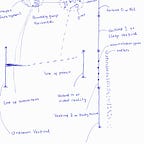For Consciousness | Sentience: Exploring Myelinated Axons and Saltatory Conduction
When electrical impulses relay across myelinated axons, jumping from node to node, in saltatory conduction, the insulation and speed — against continuous conduction in unmyelinated axons — may have something else as an advantage in a neural circuitry.
In neuroscience, some functions are said to be more localized than others in certain parts of the brain. It is also known [or experienced] that a taste is different from a smell, an emotion from a feeling and so on.
What makes circuits more specialized than others? What makes experiences different?
It is postulated that within sets of neurons responsible for functions, there are stairs or drifts that differentiate them, then apportion degrees. The stairs or drifts do rationing or fills of chemical impulses, in the right quantities, to define what a memory is, or what a sensation is and so forth.
These stairs or drifts are mostly present at synaptic clefts [vesicles and receptors], where [a set of] chemical impulses are rationed when ‘struck’ by [a set of] electrical impulses that becomes shaped by the ration — from the set — to proceed elsewhere.
It is theorized that for electrical impulses, their stairs or drifts are myelin sheaths — which they skip over, but in sets, may not all do so concurrently. They may be doing so in parallel and near sequentially with the differences determining rations or fills, or degrees, as they reach and interact with [a set of] chemical impulses.
Simply, as sets of electrical impulses leap from node to node, in a circuit, they may not be doing so at the same time. The slight differences in skip times may go on to contribute to what gets known [or experienced] and to what degree, when they strike [a set of] chemical impulses at the thalamus and in the cerebral cortex where consciousness is mostly based, shaping being and experience.
These drifts are parts of the features of electrical and chemical impulses that decide sentience and mental states. Conceptually, drift is a factor in the split of electrical impulses, where some go before others follow, explaining predictive coding, processing and prediction error.
The neural properties of consciousness directly defining how electrical and chemical impulses determine consciousness could include axons, axon terminals, nodes of Ranvier, myelin sheaths and dendrites.
